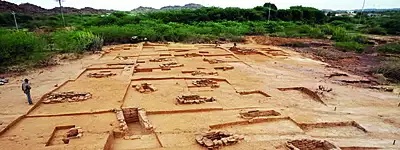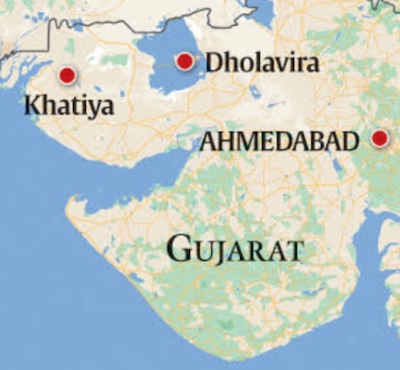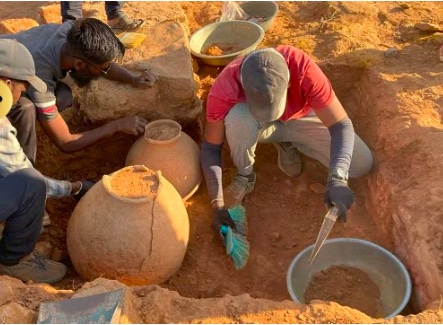Juna Khatiya
This is a collection of articles archived for the excellence of their content. |
Contents |
Pre-urban Harappan cemetery
2019-2023
Parth Shastri, January 8, 2023: The Times of India

From: Parth Shastri, January 8, 2023: The Times of India

From: Parth Shastri, January 8, 2023: The Times of India
AHMEDABAD: Excavations at one of the biggest necropolises of the Harappan era in Gujarat have shown what history has repeatedly demonstrated around the world — ancient humans buried the dead with afterlife items like personal artefacts, sacred animals, and pots of food and water.
The digging began in 2019 at Juna Khatiya village, about 30km from Lakhpat in Kutch district, and archaeologists found rows of graves with skeletal remains, ceramic pots, plates and vases, beaded jewellery, and animal bones that piqued their interest. Over time, it emerged as one the biggest Harappan burial sites, with the possibility of 500 graves, of which about 125 have been found so far.
These are from 3,200 BCE to 2,600 BCE, predating Dholavira—a Unesco world heritage site—and several other Harappan sites in the state. The site is important because others like Dholavira have a cemetery in and around the town, but no major habitation has been discovered near Juna Khatiya, said Rajesh SV, excavation director and assistant professor of archaeology at University of Kerala.
The site demonstrates the transition from earth-mound burials to stone graves. The pottery from the site have features and style similar to those excavated from early Harappan sites in Sindh and Balochistan. “The artefacts can put the site in perspective of other pre-urban Harappan sites in Gujarat,” said Rajesh.
The rectangular graves were made of shale and sandstone, which are common rocks in the area, and other than items like clay bowls and dishes, prized possessions like beads and bangles of terracotta, seashells, and lapis lazuli were interred with dead.
“The majority of burial pits had five to six pots. In one, 62 pots were found. We have not found any metal artefact from the site so far,” said Rajesh.
“Some of the burial structures have boulders of basalt as coverings. Pebbles of local rock, basalt, soil, sand, etc were used for construction, and clay was used to bind them together,” said Rajesh, delivering a lecture at IIT Gandhinagar.
The vagaries of time have taken a toll on the graves buried for five millennia: soil erosion, tilling of the land for agriculture, plus vandals opening graves in their quest for ancient treasure. “We have only one fully intact skeleton, whereas many of the graves are devoid of any human remains,” Rajesh said.
His research team includes Abhayan GS of University of Kerala, Francesc C. Conesa from Spain’s Institute of Classical Archaeology, Juan Jose Garcia-Granero of Spanish National Research Council, and Subhash Bhandari of KSKV Kachchh University. “Multiple teams are working on aspects such as DNA analysis and isotope study,” Rajesh said.
As in 2023, May
Gopal B Kateshiya,May 22, 2023: The Indian Express

From: Gopal B Kateshiya,May 22, 2023: The Indian Express

From: Gopal B Kateshiya,May 22, 2023: The Indian Express
The dry, arid soil on a 16-hectare expanse on the outskirts of Khatiya village in Gujarat’s Kutch district has thrown up several surprises — a shell bangle, pottery shards, stones blades, even human skeletal remains. Since 2018, a multi-disciplinary international team of archeologists has discovered 500 graves and excavated 197 of those here, but deep below, the site holds the key to an enduring mystery: whose graves are these? Led by Rajesh S V, Assistant Professor in the Department of Archaeology in the University of Kerala, the researchers say that while it is established that the cemetery, believed to be 5,000 years old, belonged to the ‘pre-urban’ phase of the Harappan civilisation, they are still looking for clues to see if the burial ground — arguably the largest such cemetery — could have served a big human settlement in the vicinity or if it was a common facility for a cluster of smaller settlements.
The Harappan civilisation, one of the oldest in the world, is said to have thrived along the banks of river Indus from around 5,000 BC to 1,000 BC. While the 2,500-year-long period from 5,000 BC to 2,600 BC is known as the ‘pre-urban’ Harappan phase, between 2,600 BC and 1,900 BC is the ‘urban’ Harappan phase. From there on, the civilisation declines and 1,900 BC to 1,000 BC is considered the ‘post-urban’ Harappan period. So far, the findings at the burial site are consistent with its pre-urban Harappan status.
The fragment of a shell bangle collected from the Khatiya cemetery and tested at Physical Research Laboratory (PRL), Ahmedabad, was found to be dating back to 2,850 BC. Prof Abhayan G S, Assistant Professor of Kerala University who is a co-director of the excavation project at Khatiya, said, “The pottery found as burial goods at the Khatiya site, mainly redware, buffware and grayware, is comparable to the pre-urban Harappan pottery of Sindh and Balochistan and North Gujarat.”
However, he said, “The soil in Khatiya is acidic, facilitating faster decomposition of bodies. Therefore, researchers are finding it hard to extract DNA from samples excavated from this site.”
This could then hold the answer to the Khatiya puzzle — who are the people whose remains were interred in these graves and where did they come from?
While Dholavira, the UNESCO World Heritage Site and one of the biggest metropolises of the Harappan civilisation, is also in Kutch, it is 150 kilometres away from Khatiya that’s among the western-most of the Harappan sites in India. Given the distance, researchers say, it’s unlikely that people in the urban settlements of Dholavira were buried at the Khatiya site.
“Desalpar and Khirsara, Kotda Bhadli and Nadapa are the other well-known Harappan sites in western Kutch. But each of them is a site of urban and post-urban periods of the Harappan civilisation and more than 50 km away from Khatiya. Being a pre-urban Harappan cemetery, there is a possibility that either there was a big settlement in Khatiya or there were smaller settlements around Khatiya and the cemetery was a common burial ground for them,” said Prof Rajesh, who has studied regional chalcolithic cultures (Copper Age) of Gujarat as part of his doctoral research project.
The international team of collaborators included 27 archaeologists, DNA analysts, geologists and GIS specialists from Gujarat, Maharashtra, Kerala, Spain, USA, Japan and Sweden.
Prof Subhash Bhandari, associate professor and head of Krantiguru Shyamji Krishna Verma Kachchh University (KSKVKU), Bhuj, Kutch is also part of the international team of researchers.
Having excavated parts of the cemetery in 2018-19, 2019-20 and 2021-22, Prof Rajesh, Prof Abhayan and their team are now preparing to move to a new site — Padada Bhit, a hillock on whose side there are some visible mounds. “The Padada hillock is around 1.5 km from the cemetery. But we believe the two are related,” said Prof Rajesh, who has previously worked on archaeological explorations at the Harappan sites of Navinal, Deshalpar, Janan, Mundra, Moti Chher and Nadapa in Kutch.
The team has also identified a place in Lakhapar, a village two km away, which, it is believed, could hold clues to the Khatiya cemetery.
Part of Lakhapar panchayat, Khatiya is located on the banks of the Gandi, a stream that drains into the Great Rann of Kutch (GRK). Today, the GRK is an expanse of saline mudflats, but archaeologists believe it used to be navigable in prehistoric times and that the Ghaggar-Harka-Nara river used to flow through it. Later, the river dried up, turning Kutch into an arid region.
While the researchers are preparing for their fourth excavation season this winter, in Khatiya — which has a population of merely 100, mostly of farmers or cattle-herders — villagers say they are doing their best to protect the mounds.
“A pond was dug on the south-western periphery of the ancient burial site in 2016 as part of the government’s initiative to harvest the water of Dhoro Chhelo (a stream). Lots of graves were damaged during that time,” says Narayan Jajani, 65, the former sarpanch of Lakhapar-Khatiya panchayat who was the first to alert Prof Rajesh about the cemetery when the team was conducting an exploration in the area in 2016.
Isak Sumra, the present sarpanch, says elders in the village would talk about the cemetery. “They used to say that Juna Khatiya (old Khatiya) village used to be north of this burial ground. But now, after the excavation, they are saying ours is a 5,000-year-old village. That makes us special,” says the 59-year-old.
Padta Bet
Archaeological findings of 2024
Sohini Ghosh , Gopal B Kateshiya , April 5, 2024: The Indian Express

From: Sohini Ghosh , Gopal B Kateshiya , April 5, 2024: The Indian Express

From: Sohini Ghosh , Gopal B Kateshiya , April 5, 2024: The Indian Express
The presence of the skeleton, along with pottery artefacts and animal bones, that the team of archaeologists excavated from a hillock, locally called Padta Bet, point to the presence of a 5,200-year-old Harappan settlement that was 1.5 km from the mass burial ground of Juna Khatiya, an Early Harappan necropolis.
In 2018, archeologists from the University of Kerala, working in collaboration with Krantiguru Shyamji Krishna Varma Kachchh University, Bhuj, had unearthed a mass burial site with 500 graves on the outskirts of Khatiya village in Gujarat’s Kutch district. The question then was: whose graves are these? Was this the burial ground — arguably the largest such — for a big human settlement in the vicinity or was it a common facility for a cluster of smaller settlements? Since then, the team has been looking for the remains of settlements in the vicinity.
Rajesh S V, Assistant Professor in the Department of Archaeology at the University of Kerala and co-director of the project, told The Indian Express, “The hillock at Padta Bet may be one of the sites catering to the skeletal remains (in the burial ground) found at Juna Khatiya. Right now it suggests that this was one of the many settlements whose burial site was Juna Khatiya.” The researchers believe that a network of such small Harappan settlements around the necropolis “might have played a significant role in the cultural formation of Early Harappan and subsequent occupations in this arid area.”
Within the four-hectare area of Padta Bet, the researchers identified two localities where the archaeological deposits were found during excavation – Locality 2 with artefacts from the Early Harappan era (3,200 BC to 2,600 BC), Mature Harappan era (2600 BC to 1900 BC) and Late Harappan era (1900 BC to 1700 BC), and Locality 1 with artefacts dating back to Mature Harappan era and Late Harappan era.
Professor Abhayan G S, Head of the Department of Archaeology at the University of Kerala and who led the Padta Bet excavation, said one hypothesis is that the population may have grown in the area, thus spreading out from Locality 2 to Locality 1 or that the inhabitants selected different areas to stay at different points of time.
While the habitation site appears to have only a few structures, the researchers said it is possible that much of the structural remains were eroded due to the unstable nature of the landscape.
Researchers said the pottery artefacts and the animal bones — representing cattle, sheep or goat and shell fragments that point to possible animal domestication as well as shellfish “exploitation” — are an indication of the occupation of the Harappan people. One of the most striking features of the excavation are the ceramic artefacts, which could be from one of the unidentified pottery traditions of the Harappans, involving large storage jars to small bowls and dishes, they said.
The team also found semiprecious stone beads made of carnelian and agate, terracotta spindle whorls, copper, lithic tools, cores and debitage, grinding stones and hammer stones. Archaeobotanical samples too have been collected from the site for further identification of plant exploitation and to understand agricultural practices.
The presence of the skeleton raises another question. If the mass burial site possibly catered to people in the settlement, why were the remains of this body here, and not at the Juna Khatiya burial site?
Rajesh explains that while Juna Khatiya was a burial ground from the Early Harappan phase, the skeleton at Padta Bet possibly indicates a change in burial practice over time. “It is an intentional burial and it is possible that the skeletal remains (excavated at Padta Bet) are from the Late Harappan era or there might be a practice to bury within the habitational limits. We have not seen any burial from the Late Harappan era at Juna Khatiya (the mass burial ground).”
Last year, Rajesh was awarded the Field Discovery Award by the Chinese Academy of Social Sciences of Shanghai University for his discovery of the Juna Khatiya cemetery.
The skeleton, along with the other artefacts, are currently in transit and are expected to reach Kerala in a week.